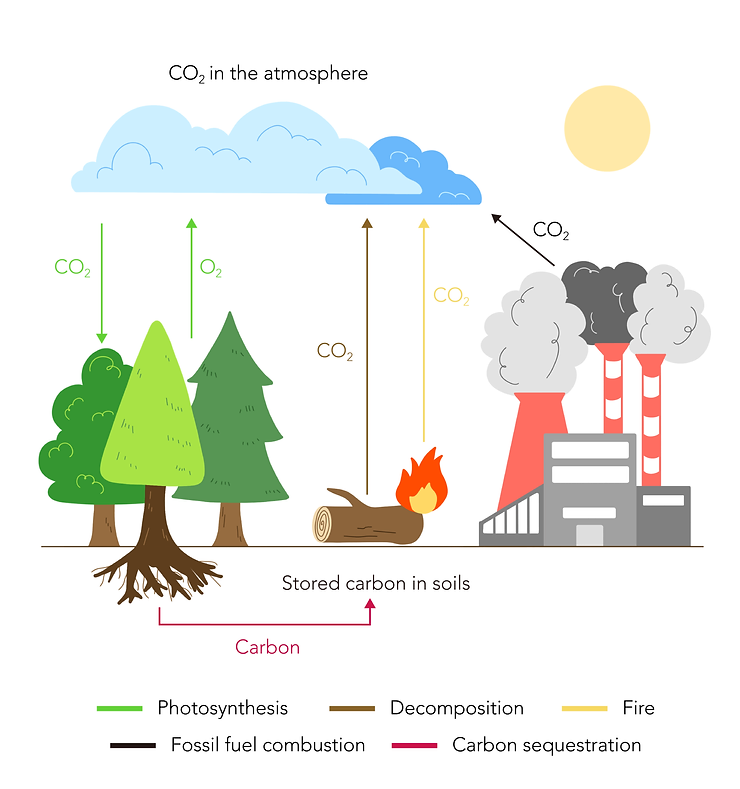Deforestation and International Trade
Author
Teresa Tsui
Hello, my name is Teresa Tsui (she/her) and I am the researcher behind this work. I am now living in the town of Bradford West Gwillimbury, Ontario, Canada, the traditional territory of the Anishinabewaki, Wendake- Nionwentsïo, Haudenosaunee and the Mississauga peoples. I moved here from my home city – Hong Kong in 2021. My home city, widely known as the world’s leading financial hub, is a place where various landscapes and rich biodiversity co-exist, which develops my interest in urban development, environmental conservation, and climate risk mitigation. I am grateful for the privilege I have, of my access to biodiversity and urban/ rural landscapes, and being able to view this world from an international perspective. I never intend to speak on behalf of any communities mentioned within this work, but rather to use my privilege to address how deforestation and international trade are related to climate change and social injustice. Through this post, I hope to not only introduce the critical roles that forests play in climate change and the provision of global traded goods, but to also showcase solutions for the government, policy makers and the general public to participate in sustainable supply-chain management.
Editors
John O’Connor
Rose Duncan

Forests cover 31% of the world’s land surface (4.06 billion hectares) and play key roles in the water cycle, soil conservation and habitat protection for terrestrial biodiversity (1). They are also crucial in mitigating climate change in the industrial age through sequestration of carbon emissions, which is a common greenhouse gas (GHG). In recent decades, global forests are mainly cleared for the expansion of agricultural land and researchers believe that this trend is driven by international trade. This article aims at describing the role of forests in climate change and global traded goods, and how their interactions trigger climate injustice.
Carbon sequestration (n.)
The process of capturing carbon through photosynthesis and storing carbon derived from atmospheric carbon dioxide (CO2) (3).
Forests and The Carbon Cycle
In the global carbon cycle, forests act as carbon sinks through carbon sequestration, and also a source of emissions as a result of industry activities such as logging and burning (2). Forests and forest soils store approximately 47% of total global carbon and they sequester atmospheric CO2 within biomass or in soil organic matter (4). A forest’s carbon is stored in the living biomass (live trees), dead wood, litter and organic matter in the ground (5).
Apart from sequestering carbon from the atmosphere, stored carbon is released back into the atmosphere through respiration in plants, decomposition, fires, and tree harvesting (3). Decomposition occurs when carbon stored in debris such as a dead tree is broken down into CO2 by bacteria. The amount of CO2 released from decomposition is multiplied in the case of forest fires. In terms of tree harvesting, the release rate of carbon depends on the purpose of harvesting (3). For instance, if trees are being cut down for the production of short-lived timber products (e.g. paper), carbon will be released very quickly (3). Alternatively, long-term timber products (e.g. furniture or lumber) will store the carbon for a longer time until the wood decays (3).

Figure 1. Carbon cycle in forests
The relationship between forest losses, climate change and international trade
Deforestation (n.) and Forest Cover Net Change
The FAO defines deforestation as “the conversion of forest to other land use independently of whether human-induced or not”. “Forest cover net change” refers to the sum of forest losses and forest gains in a given period. Thus, net change can be either positive or negative, depending on whether gains exceed losses (net gain), or vice versa (net loss) (1).
“Deforestation footprint”
It refers to the sum of imported deforestation and any domestic deforestation. Imported deforestation is the amount of deforestation in other countries that is driven by the production of food and forestry products (13) (15).
Around 54% of the world’s forests are found in only five countries (Brazil, Canada, China, Russia and the United States of America) (1). Deforestation is prevalent in the tropical climatic domain, where 45% of the world’s forests are located (1) (6). This is mainly because tropical countries are major exporters of forest commodities (13). Commodity-driven deforestation is the largest contributor to global forest loss, followed by shifting agriculture, wildfire and urbanization (2) (7). Common forest commodities include coffee, chocolate, soy, palm oil and timber. Scientists revealed that 29-39% of carbon emissions are driven by international trade, and suggested that deforestation is accelerated by global demand for commodities (14). The study by Hoang and Kanemoto (2021) calculated “deforestation footprints” of individual countries and found that consumption patterns of G7 countries drive an average loss of 3.9 trees per person per year in 2015 (13). Another study by Pendrill et al. in 2019 stated that high-income countries accounted for 40% of imported deforestation in 2013, meaning that they were responsible for 12% of global deforestation that year (15). In light of these findings, developed countries are driving deforestation overseas through consumer choices.
Developed countries, along with China and India, have increased their imported deforestation from forests, despite their efforts in obtaining net forest gains within their borders (13). Their trading partners are mainly tropical countries, including Brazil, Madagascar, Argentina, Indonesia and Côte d’Ivoire (13). According to FAO Global Resource Assessment 2020, Africa was found to have the highest annual deforestation rate in 2015–2020 (4.41 million hectares), followed by South America (2.96 million hectares) and Asia (2.24 million hectares) (16). Brazil recorded the largest annual net loss of forest area between 2010-2020 (1496 hectares per year), followed by Democratic Republic of the Congo (1101 hectares per year), and Indonesia (753 hectares per year) (16).
Brazil has the world’s largest tropical forest area, which makes the country a major exporter of soy and beef (13). Forests in the country were cleared for agriculture and grazing due to the consumption pattern of the EU-27 nations, the US and China (13). Brazil, and other tropical countries such as Indonesia and Mexico, have changed their forest cover for forest commodities faster than they reduced their net forest losses through strategic forest management (13). International trade promotes socio-economic development in a country; given that developing countries have a comparatively weaker financial foundation than that of developed countries, farmers heavily rely on international buyers to earn a living and improve their livelihoods.
Although converting forests to agricultural lands has been farmers’ way of living, its associated climate-risks should not be neglected. Converging evidence indicates that deforestation has exacerbated global warming and induced climate change. In 2000 to 2010, temperatures in deforested tropical and temperate regions increased approximately 0.38 and 0.16 degree Celsius respectively (8). Temperature changes driven by deforestation are resulted from the modifications in albedo (i.e. the amount of sunlight reflected by a surface back to the atmosphere), and evapotranspiration (i.e. transpiration and evaporation of water into the atmosphere) (9). Furthermore, deforestation is also associated with a decline in rainfall frequency and intensity (10). In Brazil, there are observations showing a decreasing rainfall frequency and increasing intensity within deforested areas of land (11). Higher occurrence of extreme weather events is observed in areas with declining forest cover. Frequent and longer floods happened in 1990-2000 as forest cover in countries of tropical regions decreased (12). Decline in forest cover causes greater water run-off in heavy rainfall events as soil infiltration and canopy interception are reduced. We should be highly alerted that every country will be affected by adverse effects of climate change, especially vulnerable countries who are prone to extreme weather events.
Countries involved in forest product export, and those who import vast amounts of forest products, need to be more conscious of how they are contributing to global deforestation, and thus climate change. Policy makers should formulate stricter guidelines on supply chains by improving transparency, stakeholders engagement, and financial support for tropical regions, and reform zero-deforestation policies through cooperation between nations. Another viable option is to encourage farmers to adopt new farming practices that favours sustainable development, such as agroforestry. Agroforestry system is an integration of forests into agricultural land uses which has been gaining significant research interest in recent years owing to their various benefits including economic diversification, climate change mitigation, improved soil and water quality, and enhanced biodiversity. They are particularly crucial to smallholder farmers as they could maximize crop yields and economic revenue. Every measure mentioned above must ensure farmers and their communities have the skills and knowledge to participate in sustainable supply-chain management, and engage them at the center of the government’s policy and decision-making processes.
References
- FAO. (2020). Global Forest Resources Assessment 2020 – Key findings. Rome. Retrieved from https://www.fao.org/documents/card/en/c/ca8753en
- Mitchard, E. T. A. (2018). The tropical forest carbon cycle and climate change. Nature. 559: pp 527-534.
- Sedjo, R., Sohngen, B. (2012). Carbon sequestration in forests and soils. Annual Review of Resource Economics. 4: pp 127-144.
- Malhi, Y., Meir, P., Brown, S. (2002). Forests, carbon and global climate. Royal Society. 360(1791): pp 1567–1591.
- FAO. (2022). The State of the World’s Forests 2022 – Forest pathways for green recovery and building inclusive, resilient and sustainable economies. Rome. Retrieved from https://www.fao.org/documents/card/en/c/cb9360en
- FAO. (2016). The State of the World’s Forests 2016. Forests and agriculture: land-use challenges and opportunities. Rome. Retrieved from https://www.fao.org/publications/sofo/2016/en/
- Curtis, P. G., Slay, C. M., Harris, N. L., Tyukavina, A., Hansen, M. C. (2018). Classifying drivers of global forest loss. Science. 361: pp 1108-1111.
- Prevedello, J. A., Winck, G. R., Weber, M. M., Nichols, E., Sinervo, B. (2019). Impacts of forestation and deforestation on local temperature across the globe. PLoS ONE. 14(3): e0213368.
- Vargas Zeppetello, L. R., Rarsons, L. A., Spector, J. T., Naylor, R. L., Battisti., D., Masuda, Y. J., Wolff, N. H. (2020). Large scale tropical deforestation drives extreme warming. Environmental Research Letters. 15: 084012.
- Lawrence, D., Vandecar, K. (2015). Effects of tropical deforestation on climate and agriculture. Nature Climate Change. 5: pp 27-36.
- Webb, T. J., Woodward, F. I., Hannah, L. & Gaston, K. J. (2005). Forest cover–rainfall relationships in a biodiversity hotspot: the Atlantic forest of Brazil. Ecological Applications. 15: pp 1968–1983.
- Bradshaw, C. J. A., Sodhi, N. S., Peh, K. S. H., Brook, B. W. (2007). Global evidence that deforestation amplifies flood risk and severity in the developing world. Global Change Biology. 13(11): pp 2379-2395.
- Hoang, N. T., Kanemoto, K. (2021) Mapping the deforestation footprint of nations reveals growing threat to tropical forests. Nature Ecology & Evolution. 5: pp 845-853.
- Pendrill, F., Persson, U. M., Godar, J., Kastner, T., Moran, D., Schmidt, S., Wood, R. (2020). Agricultural and forestry trade drives large share of tropical deforestation emissions. Global Environmental Change. 63: 102103.
- Pendrill, F., Persson, U. M., Godar, J., Kastner, T. (2019). Deforestation displaced: trade in forest-risk commodities and the prospects for a global forest transition. Environmental Research Letter. 14: 055003.
- FAO. (2020). Global Forest Resources Assessment 2020. Rome. Retrieved from https://www.fao.org/3/ca9825en/ca9825en.pdf


